Product Images Xarelto
View Photos of Packaging, Labels & Appearance
- Bottle Label 10 mg - 71610 0690 42
- Aphena Pharma Solutions - TN - Aphena
- Figure 1 - xarelto 01
- Chemical Structure - xarelto 02
- Figure 2 - xarelto 03
- Figure 3 - xarelto 04
- Figure 4 - xarelto 05
- Figure 5 - xarelto 06
- Figure 6 - xarelto 07
- Figure 7 - xarelto 08
- Figure 8 - xarelto 09
- Figure 9 - xarelto 10
- Figure 10 - xarelto 11
- Figure 11 - xarelto 12
- Figure 12 - xarelto 13
- Image - xarelto 14
- Image - xarelto 15
- Image - xarelto 16
- Image - xarelto 17
- Image - xarelto 18
- Image - xarelto 19
- Image - xarelto 20
- Image - xarelto 21
- Image - xarelto 22
- Image - xarelto 23
- Image - xarelto 24
- Image - xarelto 25
- Image - xarelto 26
- Image - xarelto 27
- Image - xarelto 28
- Image - xarelto 29
- Image - xarelto 30
- Image - xarelto 31
- Image - xarelto 32
- Image - xarelto 33
Product Label Images
The following 35 images provide visual information about the product associated with Xarelto NDC 71610-690 by Aphena Pharma Solutions - Tennessee, Llc, such as packaging, labeling, and the appearance of the drug itself. This resource could be helpful for medical professionals, pharmacists, and patients seeking to verify medication information and ensure they have the correct product.
Bottle Label 10 mg - 71610 0690 42
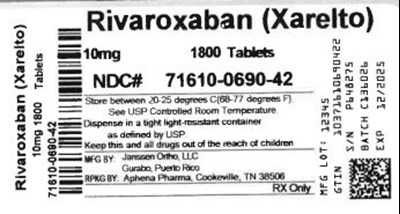
This is a medication called Ivaroxaban, which is also known as Xarelto. The bottle contains 1800 tablets of 10 milligrams each with a National Drug Code (NDC) number of 71610-0690-42. The other information appears to be illegible or not available.*
Figure 1 - xarelto 01

This is a table of data with percentages related to patient characteristics, such as prior use of warfarin, age, gender, weight, diabetes status, CHADS2 score, geographic region, ASA use at randomization, and treatment with either rivaroxaban or warfarin. It also includes hazard ratio and 95% confidence intervals related to favoring treatment with rivaroxaban over warfarin. No further information or context is available.*
Figure 2 - xarelto 03
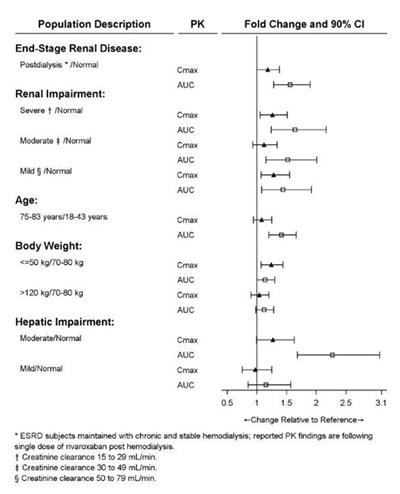
This text contains pharmacokinetic (PK) information for the drug rivaroxaban in different populations. It provides fold change and 90% confidence interval for the PK parameters Cmax and AUC post dose. The populations evaluated include those with end-stage renal disease (ESRD), renal impairment, variations in age and body weight, and hepatic impairment. The results are specific to those with creatinine clearance levels ranging from severe to normal, and the ESRD data represents subjects maintained with chronic and stable hemodialysis.*
Figure 3 - xarelto 04

This is a table of drug interactions and their effect on the pharmacokinetics (PK) of different drugs, specifically their maximum concentration (Cmax) and area under the concentration-time curve (AUC). The first section refers to combined inhibitors of the P-glycoprotein (P-gp) transporter and the CYP3A enzyme, while the second section refers to moderate CYP3A inhibitors and other drugs. The last row shows the fold change in the PK parameters compared to the drug rivaroxaban alone.*
Figure 9 - xarelto 10
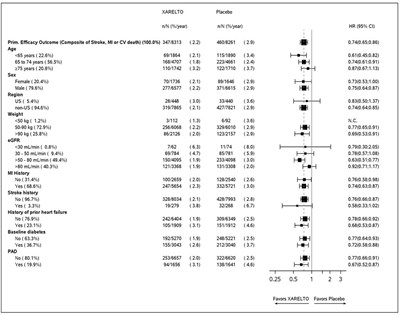
This appears to be a statistical table providing data on the effectiveness of XARELTO in comparison to placebo across different age groups, weight range, and medical history. The efficacy of XARELTO was measured by a composite outcome of stroke and death from cardiovascular causes. The table also includes data on the characteristics of the study population, including age, sex, geographical location, weight range, and medical history of heart attack, diabetes, and heart-taker.*
Figure 10 - xarelto 11
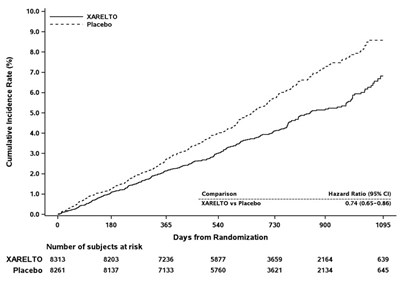
This appears to be a graph showing the cumulative incidence rate of XARELTO versus a placebo over a period of 1095 days from randomization. The graph shows the percentage of subjects at risk and the number of subjects at risk. The vertical axis shows the cumulative incidence rate in percentage while the horizontal axis shows the number of days from randomization.*
Figure 11 - xarelto 12
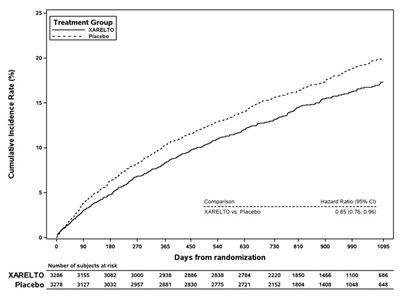
The text provided seems to be a table presenting data on Cumulative Incidence Rate (%) for a comparison between XARELTO and Placebo. The table divides the data into two treatment groups and presents a comparison under "Hazard Ratio (55% C)." The table includes data related to the number of subjects at risk and days from randomization. No additional information is available to provide a more detailed description.*
Image - xarelto 18

The text is not-available because there is not enough information to generate a useful description.*
Image - xarelto 19

This text is a prompt to check and mark the expiration date of a product with the message "Discard after".*
Image - xarelto 24

This text appears to be a table or list showing various measurements in milliliters (mL) and the composition of each measurement in terms of smaller volumes of 5mL. Without further context, it is difficult to determine what the purpose or meaning of this information is.*
* The product label images have been analyzed using a combination of traditional computing and machine learning techniques. It should be noted that the descriptions provided may not be entirely accurate as they are experimental in nature. Use the information in this page at your own discretion and risk.
























